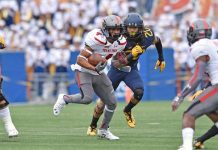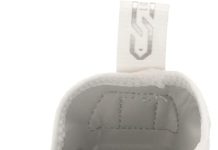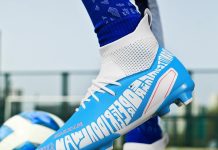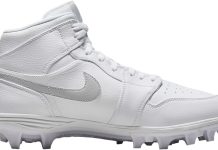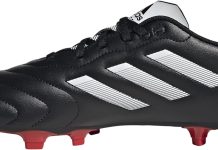In the world of football, the choice of studs on our boots can make a significant difference in our performance on the field. Whether it’s a muddy pitch, a dry and hard surface, or somewhere in between, understanding the right type of studs can give us the edge we need to tackle any field condition. In this article, we will explore the various types of studs available and uncover the secrets to mastering different field conditions in football. So, get your laces tied and let’s dive into the world of studs!
Hard Ground
Review contents
Firm Ground Studs
When playing on hard ground conditions, it’s essential to choose the right boots that provide optimal traction and stability. Firm ground studs are designed specifically for such surfaces, ensuring excellent grip without sinking too deep into the ground. These studs typically feature conical or triangular shapes with slightly rounded edges, allowing players to quickly change direction and accelerate without losing balance. The evenly distributed studs help to minimize the risk of slipping and provide a solid foundation for enhanced performance on hard ground.
Bladed Studs
Bladed studs, also known as blades or blades studs, are another suitable option for hard ground surfaces. These types of boots feature studs that have a more narrow, shovel-like shape, resembling the blades of a knife. The unique design of bladed studs provides stability and improved speed control on hard ground, as the sharp edges penetrate the surface for maximum traction. By reducing the amount of stud-to-ground contact compared to other types of studs, bladed studs can also reduce the risk of injury on firm surfaces, making them a popular choice for players on hard ground.
Artificial Turf
Astro Turf Studs
Artificial turfs, commonly known as Astro Turf, require specific stud patterns to optimize performance. Astro Turf studs are generally shorter and more numerous than those used on natural grass. With a greater number of smaller studs, these boots offer increased grip on artificial turf, allowing players to maneuver with confidence. The shorter stud length prevents excessive stud penetration into the turf, minimizing the risk of injuries during fast movements and sharp turns. The distributed stud pattern also aids in weight distribution, enhancing balance and stability on artificial turf surfaces.
Short Studs
Another option for artificial turf conditions is boots with short studs. Unlike longer studs designed for natural grass, short studs offer precise traction without the risk of excessive grip or sinking into the artificial surface. The reduced stud length ensures a consistent grip without putting undue stress on the joints and ligaments, promoting agility and preventing the risk of injury. Short studs perform exceptionally well on artificial turf, providing the necessary traction to maintain control while keeping the potential for turf-related accidents at bay.
This image is property of trainingground.guru.
Grass
Soft Ground Studs
When faced with soft ground conditions, such as wet or muddy grass, soft ground studs are the ideal choice. These studs are longer and often have a tapered or screw-like shape, allowing them to grip into the softer terrain for maximum traction. Soft ground studs excel in providing stability and preventing slippage on uneven and waterlogged grass surfaces. The increased surface area of the studs helps distribute the player’s weight, preventing their feet from sinking into the ground and maintaining balance and control throughout the game.
Firm Ground Studs
Firm ground studs, as the name suggests, are suitable for grass fields with firm or dry ground conditions. These studs usually have a conical shape, providing reliable grip on moderately firm grass surfaces. The slightly shorter length of firm ground studs reduces the risk of penetration into the ground, ensuring stability without compromising mobility. Firm ground studs are versatile and can perform adequately on various grass conditions, making them a safe and reliable choice for most matches played on traditional grass fields.
Wet Conditions
Screw-In Studs
For playing football in wet conditions, screw-in studs offer a practical and adaptable solution. These studs allow players to customize the length of the studs based on the specific wetness and softness of the ground. By being able to interchange the studs, players can adjust their footwear to have longer studs for improved traction on waterlogged pitches. The screw-in studs provide extra grip and help prevent slipping, making them a perfect choice for wet conditions where stability and traction are critical.
Soft Ground Studs
Soft ground studs are also suitable for wet conditions, especially when the grass is saturated, muddy, or waterlogged. The longer and more aggressive stud design prevents the players’ boots from getting stuck in the mud, providing the necessary grip to navigate in wet and slippery conditions. These studs are engineered to penetrate the soft ground and maintain stability, allowing the player to remain grounded while executing precise movements and quick turns.
Modified Firm Ground Studs
In some wet conditions, where the ground is not excessively soft or muddy, modified firm ground studs can be an excellent alternative. These studs combine the benefits of both firm ground and soft ground studs, offering a perfect balance between grip and stability. Modified firm ground studs typically feature shorter conical studs with slightly wider bases, allowing for better penetration on damp surfaces while still keeping the desired stability on moderately firm terrains. This versatility makes the modified firm ground studs a reliable choice for football players facing varying wet ground conditions.
This image is property of www.sportsmith.co.
Dry Conditions
Firm Ground Studs
Dry conditions call for firm ground studs due to the firmness and lack of moisture on the field. These studs are designed to provide stability and excellent traction, allowing players to accelerate, change direction, and maneuver effectively on dry grass surfaces. Firm ground studs typically have conical shapes, spreading the player’s weight evenly and minimizing the risk of slipping during intense gameplay. With their reliable grip on dry ground, firm ground studs ensure players can showcase their skills and perform at their best.
Bladed Studs
Bladed studs are also suitable for dry conditions, offering players enhanced control and stability on firm grass surfaces. The unique blade-like design increases the number of points of contact with the ground, maximizing traction and preventing slippage. The sharp edges of the studs dig into the dry grass, providing players with the confidence to make sharp turns and changes in direction without compromising their footing. Bladed studs excel in dry conditions, enabling players to exhibit their agility and precision during fast-paced matches.
Muddy Conditions
Screw-In Studs
Muddy conditions pose a significant challenge, but screw-in studs can help players overcome the difficulties associated with such field conditions. The ability to customize the stud length makes screw-in studs an excellent choice for muddy fields. By adjusting the studs to a longer length, players can ensure maximum penetration into the mud, maintaining stability and preventing their feet from getting stuck. The versatility and adaptability of screw-in studs make them an essential footwear option for players dealing with muddy conditions.
Soft Ground Studs
Soft ground studs, which excel in wet conditions, are also suitable for muddy fields. The longer length and aggressive design of these studs allow for effective grip and release of mud while providing much-needed traction on soft, slippery surfaces. The soft ground studs’ ability to prevent excessive build-up of mud provides players with a reliable foothold and reduces the risk of slipping or losing balance in challenging muddy conditions.
This image is property of cdn.shopify.com.
Frozen Ground
Aluminum Studs
Playing on frozen ground requires specific stud configurations, such as aluminum studs. These studs are designed to cope with the hard and unforgiving nature of frozen surfaces. With their durability and resistance to deformation, aluminum studs provide players with reliable traction on icy terrain. The hardness of frozen ground calls for studs that can penetrate the surface without compromising stability, and aluminum studs effectively fulfill this requirement, ensuring players can keep their footing and confidently perform in frozen conditions.
Hard Ground Studs
While not specifically designed for frozen ground, hard ground studs can also offer reasonable grip on icy surfaces. These studs maintain stability and traction, preventing players from slipping and sliding on frozen ground. Hard ground studs typically have conical shapes and provide a secure grip without excessive penetration into the surface, making them a viable option when playing on frozen ground.
Sand
Turf Cleats
Playing on sandy surfaces requires a different type of stud configuration to ensure optimal performance. Turf cleats are specifically designed to adapt to sandy conditions. These cleats feature shorter studs with flat bottoms, enabling them to provide grip without sinking too deeply into the loose sand. The broader surface area of the cleats helps displace the sand, ensuring players maintain stability and improved traction on sandy terrain.
Multi-Stud Cleats
Multi-stud cleats also perform well on sand due to their design and stud arrangement. These cleats feature multiple small studs distributed across the sole, working together to provide grip and prevent excessive sinking into the sand. The evenly spaced studs help players maintain balance and stability, allowing them to move freely and confidently across sandy surfaces.
This image is property of cdn.footy.com.
Snow
Screw-In Studs
When playing football in snowy conditions, screw-in studs continue to be a reliable choice. Much like in wet or muddy conditions, screw-in studs allow for stud customization to match the specific snow conditions. By adjusting the stud length, players can ensure they have enough grip to navigate the potentially slippery snowy surfaces. The versatility provided by screw-in studs makes them a preferred option when playing in snow.
Artificial Grass Studs
For synthetic turfs covered in snow, artificial grass studs offer exceptional traction and stability. These studs are specifically designed to provide optimal grip on artificial grass surfaces, and their design helps prevent slipping when the turf is covered in snow. Artificial grass studs combine the benefits of short studs and multi-stud cleats, ensuring players can confidently play on snow-covered synthetic fields.
Uneven Terrain
Hard Ground Studs
When confronted with uneven terrains, such as rough or patchy grass fields, hard ground studs offer the stability and traction necessary for safe and efficient gameplay. The conical shape and reliable grip of hard ground studs allow players to maintain balance and prevent slipping, even on uneven surfaces. These studs distribute the player’s weight evenly, minimizing the risk of accidental falls or twists resulting from uneven terrains.
Turf Cleats
Uneven terrains also call for the adaptability of turf cleats. The flat bottoms and shorter studs of turf cleats ensure players can maneuver effortlessly on rough or patchy grass fields. The broader surface area of turf cleats helps disperse the pressure, reducing the risk of foot discomfort and providing a reliable foothold on uneven terrains. Turf cleats excel in offering stability and traction, enabling players to play confidently regardless of the surface conditions.
Bladed Studs
For players seeking enhanced control on uneven terrains, bladed studs can be an excellent choice. The blade-like shape of these studs increases the number of contact points with the ground, allowing for more precise movements on rough or patchy grass fields. The improved grip and stability provided by bladed studs enable players to maintain control and confidently navigate uneven terrains.
Whether it’s hard ground, soft ground, artificial turf, or any other type of field condition, choosing the right studs is crucial for football players. Each surface requires a particular stud design to optimize performance, prevent injury, and maintain traction and stability. By considering the characteristics of different studs and field conditions, players can make informed decisions about their footwear, ultimately enhancing their game and enjoying football to the fullest in any playing environment.
This image is property of cdn.shopify.com.










